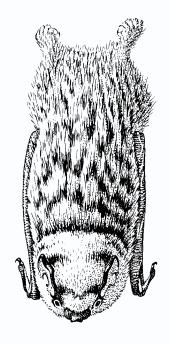
Bats are the only mammals capable of true flight; others, such as “flying” squirrels, only glide. Their wings have little or no fur while the rest of their bodies are well furred. The eight species found in Saskatchewan are members of the family Vespertilionidae or smooth-faced bats. They have large ears and small eyes and they eat nothing but insects, mostly flying ones. Bats are small; those in Saskatchewan range in mass from 6 to 30 g.
Bats are active at dusk, dawn and/or night. They can navigate in complete darkness by using sound, a system called echolocation. The intense sounds they produce are high pitched, usually above the range of human hearing. Echoes from these calls bounce off objects, providing bats with information about size, shape and distance and whether the object is a potential meal or an obstacle. Bats eat a variety of insects, but different species tend to have preferences. Little brown bats mainly eat small, soft-bodied insects such as midges, often hunting over calm bodies of water. Hoary and big brown bats, which are larger, stronger fliers and have more powerful jaws, eat harder-bodied prey such as beetles. Saskatchewan bats have two options to cope with winter when insects are unavailable. Some, like the red, hoary and silver-haired bats, migrate south while others hibernate in shelters such as caves or abandoned mines. Few hibernation sites are known in Saskatchewan.
Bats' rear legs are small, with five clawed toes on each foot, used when they hang upside down in roosts with their wings folded against their bodies. Bats are able to conserve their fat stores by lowering their body temperatures while roosting. While most small mammals reproduce often over a short life, bats tend to have few young and live long. Thirty-year old little brown bats have been caught. Most species give birth to a single pup, although twins occur and red bats may have litters of four. Young bats fly and begin foraging approximately four to six weeks after birth.
There are many myths about bats; but they are not blind, do not fly into people's hair, and do not suck blood. The most terrifying aspect for many is the assumption that most are rabid. Bats can indeed succumb to this disease, and any bat lying on the ground should not be touched. However, the vast majority of bats are healthy.
Raccoons, weasels, cats, snakes, hawks and owls occasionally catch bats, but humans inflict the most damage. Because many bat species are colonial, large numbers can easily be destroyed. If hibernating bats are disturbed they awaken, which costs energy and increases the possibility that the bat's stored fat will be insufficient to keep it alive all winter.
Mark Brigham